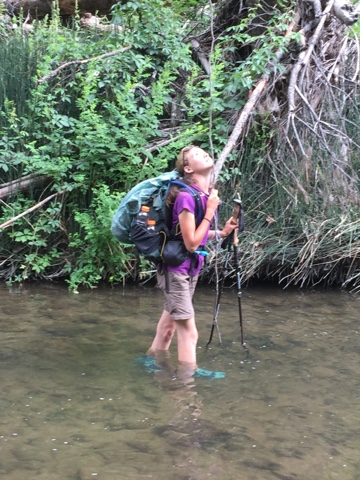Footprints cover the sandy trail. Human footprints. We are now hiking up the Middle Fork of the Gila River in the Gila Wilderness, the first designated wilderness area at the urging of Aldo Leopold, then working in the area as a young forester.
Over 100 crossings. We've been told to expect more than 100 river crossings along this section of the Middle Fork of the Gila River. We cross almost immediately. One down, 99 to go?!
Farther up the canyon, steam rose from pools in the creek. We stepped into a warm bath, letting the steam rise to our faces. The Gila Hot Springs. Above, cool dark caves back on in the reddish tan cliffs.
Bzzzzzz. As I crashed through an overgrown section of brush, a short warning rattle alerted me to danger. Bzzzzz. Do I step back into the poison ivy or forward into range of the angry rattlesnake? My decision was made easy as I glanced down to see the rattling tail slithering away into the brush. Later in the day a second rattlesnake would take more of a "stand your ground" approach, rattling angrily while coiled and ready to strike until we cautiously backed away in retreat.
A few miles up the trail, we are met with a strange sight. Another human. The first human we've seen on the trail since we started at the Mexican border. Tamara, or "Tamale" as she is sometimes known on trail, works for Arizona Trail and was out for a quick weekend jaunt. It is her first time at the Gila and she seems just as amazed as we are. By the end of the day, we would see more than 20 people, covering the gamut from experienced locals like Ryan aka Tramper to new hikers carrying uncomfortable army surplus packs.
Lush and green, the canyon teems with life. We step carefully through each crossing to avoid schools of Gila trout, tiny tadpoles, or anxious frogs. A young deer laps water at the river. Butterflies flit from one golden sunflower to the next. Grouse grunt incessantly, hoping to find a mate. We wonder whether the constant grunting noise actually attracts the females or if the females join the males just to get them to finally be quiet.
We stopped for lunch at Jordan Hot Springs, where a waterfall of naturally hot water tumbles into a crystal clear pool. The hot water soothed tired muscles and relaxed us until we almost forgot we needed to get back on the trail.
Lower in the canyon, the walls rose up like a castle, topping out in rocky spires and turrets. Farther up the canyon, the steep canyon walls reminded me of the columnar basalt at Devils Postpile National Monument.
Frequent river crossings, deep sand, rocky dry river bottom, downed trees, spectacular views, friendly hikers, and prolific poison ivy all conspired to slow our progress. Reaching The Meadows, a gorgeous grassy valley ringed with tall pines and rugged, vertical rock walls, we decided to camp.




















































